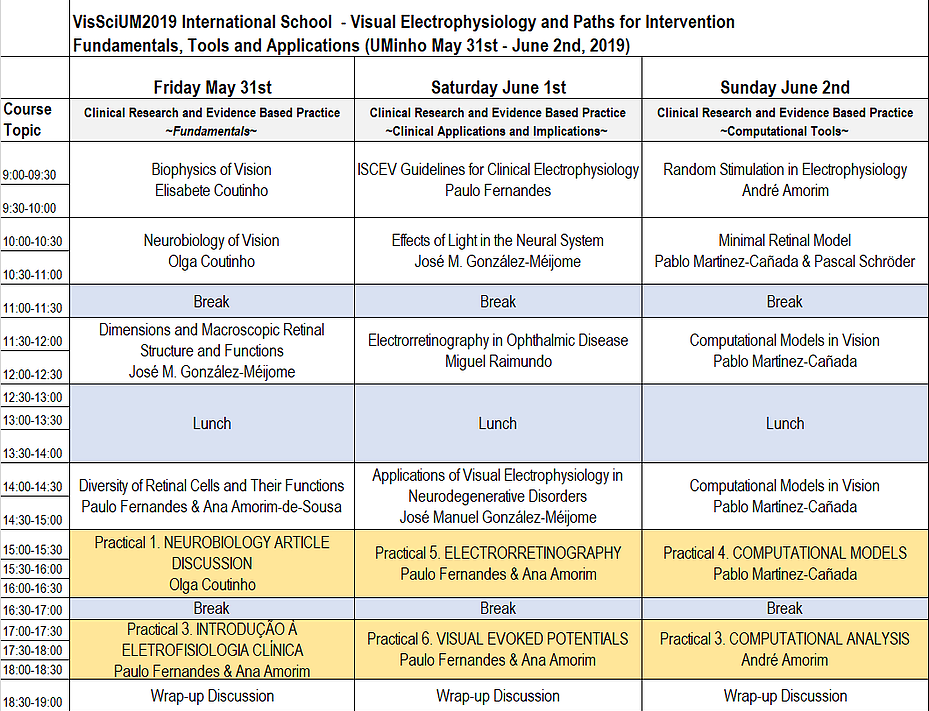
Visual Electrophysiology and Interventions

Learning outcomes of the course:
This course aims to develop advanced technical and scientific competencies on the domain of visual neurophysiology and the interaction with retinal image formation, processing and interpretation with the goal that the post-graduation student develops competitive research in the area of visual electrophysiology in healthy and disease eyes as well as the modification of the electrophysiological response through different optical interventions.
Directed to PhD Students and final year MSc Students in any field related with clinical research and clinical practice.
Visual electrophysiology and paths to optical intervention
1. Learning outcomes of the curricular unit (knowledge, skills and competences to be developed by students):
In the end of the course, the students must be able to:
- Understand the neurobiological mechanisms involved in the visual process.
- Demonstrate advanced knowledge of retinal layers and visual pathways in the visual process.
- Understand the origin of the bioelectrical signals in the retina and interpret the intrinsically characteristics signals of each cellular group.
- Be able to perform the different electrophysiological techniques for retina and visual cortex assessment and evaluate those electrophysiological activity using appropriate protocols.
- Construct computational models of the electrophysiological activity of the retina
- Hypothesize routes for future research and design research protocols involving electrophysiological and neurophysiological modeling techniques.
- To develop competitive research about electrophysiological response of the eye in diseased and healthy eyes and relate it with the response obtained by the induction of different customized optical stimuli
2. Syllabus:
Theoretical component
- Macroscopic and microscopic anatomy of the visual system
- Neurobiology and biophysics of the visual system
- Cellular types and their function in the visual process
- Processing of visual information
- Techniques for visual electrophysiological evaluation and the influence of different stimulation paradigms on retina response at a cellular level.
- Structure and function in retinal disease
- Clinical applications of visual electrophysiology
- Effect of customized visual stimulation in the electrophysiological response
- Optical manipulation of the visual electrophysiological response
- Other applications in neurodegenerative research
- Computational models of the neuronal retina and visual processing
Practical component
- Practical work in visual electrophysiology
- Research protocols in visual electrophysiology
- Laboratory work in electrophysiology
- Practical work in computational neural modelling and data processing
General books and papers:
- Kolb H, Fernandez E, Nelson R, editors. Webvision: The Organization of the Retina and Visual System [Internet]. Salt Lake City (UT): University of Utah Health Sciences Center; 1995-. https://www.ncbi.nlm.nih.gov/books/NBK11530/
- Valberg, Arne. Light Vision Color. The Norwegian University of Science and Technology. John Wiley & Sons Ltd; 2005
- Werner J, Chalupa M, editors. The New Visual Neurosciences. Massachusetts Institute of Technology. MIT Press 2014- Heckenlively J, Arden G, editors. Principles and Practice of Clinical
- Electrophysiology of Vision. Massachusetts Institute of Technology. MIT Press 2006
- Carlos Martins J, Augusto Sousa L. Bioelectronic Vision: Retina Models, Evaluation Metrics, and System Design. Series on Bioengineering & Biomedical Engineering — Vol. 3. World Scientific Publishing Co. Pte 2009
- Masland RH. The neuronal organization of the retina. Neuron. 2012 Oct 18;76(2):266-80. doi: 10.1016/j.neuron.2012.10.002
- Gollisch T. Eye smarter than scientists believed: neural computations in circuits of the retina. Neuron. 2010 Jan 28;65(2):150-64. doi: 10.1016/j.neuron.2009.12.009.
- Tianruo G. Understanding the Retina: A Review of Computational Models of the Retina from the Single Cell to the Network Level. Critical Reviews in Biomedical Engineering 2014, 42(5):419–436.
